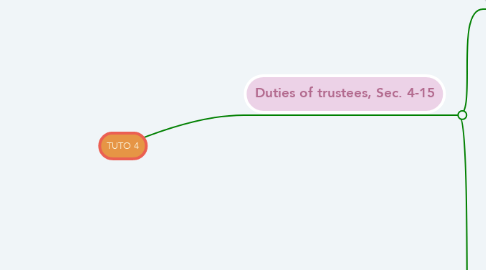
1. Duties of trustees, Sec. 4-15
1.1. Duty to invest
1.1.1. Strict approach
1.1.1.1. Requires authorisation - Bethell v Abraham
1.1.2. Liberal approach
1.1.2.1. may make investment outside authorisation - Re Harari
1.1.3. Breach of duty
1.1.3.1. A trustee would discharge his duties if he takes all the precautions in managing which an ‘ordinary prudent man of business’ would take would take in managing similar affairs of his own – Speight v Gaunt (1893)
1.1.3.2. Trustee must exercise their powers in the best interest of the present and future beneficiaries of the trust – Cowan v Scargill (1985)
1.1.3.3. Nestle v National Westminster Bank (1994) P contended that the trustee failed to invest in a manner that would yield a higher return. H: there was no breach of trust just because they acted less profitably – this is different from acting wrongly (misfeasance in the management) which caused loss.
1.1.3.3.1. Objective test: They has acted in the same manner as other trustees in the same position. The court will look at other trustees investing in a similar type of risk-averse family trust rather than comparing with the entire equities market.
1.1.4. Sec. 4 - authorised investments
1.1.5. Sec. 6 - duty of trustees in choosing investments
1.1.5.1. The need for diversification Degree of risk attached Appropriate to the type of trust Whether the described proposed investment fits the actual investment
1.2. Golden Rule of Investment
1.2.1. Duty to act fairly between beneficiaries
1.2.2. Duty to make the best investment return
1.2.2.1. duty to generate income, best financial interest
1.2.2.1.1. Cowan v Scargill (1984)
1.2.3. Duty to act prudently and safely
1.2.3.1. entail low risk investment
1.2.3.2. avoid all investment of a hazardous nature.
1.2.3.2.1. Learoyd v Whiteley
1.2.3.3. take care as ordinary prudent man would
1.2.3.3.1. Bartlett v Barclays Bank (1980)
